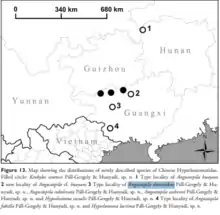Angustopila dominikae
Angustopila dominikae is a species of light grey, round, land snails, a terrestrial pulmonate gastropod mollusk in the family Hypselostomatidae. Angustopila dominikae have been found in southern China, and are considered to be the world's smallest terrestrial mollusk (the holotype's shell height is 0.86 mm).[1] This species is a variation of tropical snail found on limestone caves and cliffs.[2] As is the case in most other members of the genus Angustopila, A. dominikae is a troglobiont species.
| Angustopila dominikae | |
|---|---|
.png.webp) | |
 | |
| Two views of the shell (above) and the same shell in the eye of a needle. | |
| Scientific classification | |
| Kingdom: | |
| Phylum: | |
| Class: | Gastropoda
clade Heterobranchia clade Euthyneura clade Panpulmonata clade Eupulmonata clade Stylommatophora informal group Orthurethra |
| Family: | |
| Genus: | |
| Species: | A. dominikae |
| Binomial name | |
| Angustopila dominikae Páll-Gergely & Hunyadi in Páll-Gergely, Hunyadi, Jochum & Asami, 2015 | |
Name and current record status
The snails were named after Páll-Gergely's wife, Dominika.[3] It has been called the “world's smallest snail”[4][5] The current world record for the smallest snail is currently taken by Angustopila dominikae from Guangxi, China.[6] Angustopila dominikae grows to, at most 0.86 mm.[7] Some unidentified micro-mollusks found in the forests of Argao, Cebu can be smaller in size than Angustopila dominikae, but these species must be further studied before they can stake claim to the title of “Worlds Smallest Snail”. A researcher whom is searching Argo in an attempt to beat the record was quoted saying, “It would be a great discovery if our micro mollusks in Argao (Cebu) would be proven to be the smallest snail in the world,” -Professor Rama Rosales.[8]
Physical characteristics
The Angustopila dominikae holotype has a shell that is light grey in color, having 1.5 whorls (repeating spirals or circles) when it is a protoconch. The protoconch is finely pitted and granular and collectively radiates from the nuclear whorl and ceases at the second.[9] This species is also extremely small, approximately 10 can fit in the eye of a needle. [10][1]
Discovery
This species was first found in a soil sample of limestone rocks at the base of a cliff in Guangxi, China, off the cliffs at the southern edge of Jiaole Cun and is believed to live on the cavern walls of the limestone.[11]
Diet
The diet of these snails consists of feeding on microorganisms like bacteria and fungal filaments. Jochum, a researcher, hypothesizes that the round shape of the shells of this new species may enable them to wedge themselves into tiny cracks in rocks for further food resources.[12] It could also allow them to trap air bubbles in their shell and float in water, in case they become dislodged by rain, and also probably enables them to survive being eaten by a predator.[11]
Reproduction
These snails are most likely thought to be hermaphroditic by researchers, and change their sex based on what other snails are around their habitat.[11]

Conservation status
Population size of Angustopila domminikae is currently unknown due to the strenuous methods needed to collect specimens of Angustopila domminika. Researchers have only found the single empty shell of this species. However Angustopila domminikae's conservation status is Critically Endangered (CR), because the species has only been found once, and in one place in the world.[13] This location in China also has potential threats to its natural habitat because of quarrying in this area. However because so little is known of this species there can be no definitive known threats to this species. [14]
References
- Páll-Gergely, Barna; Hunyadi, András; Jochum, Adrienne; Asami, Takahiro (28 September 2015). "Seven new hypselostomatid species from China, including some of the world's smallest land snails (Gastropoda, Pulmonata, Orthurethra)". ZooKeys (523): 31–62. doi:10.3897/zookeys.523.6114. PMC 4602296. PMID 26478698.
- Gorrell, Michael Gorrell (2011). "E-books on EBSCOhost: Combining NetLibrary E-books with the EBSCOhost Platform". Information Standards Quarterly. 23 (2): 31. doi:10.3789/isqv23n2.2011.07. ISSN 1041-0031.
- Pappas, Stephanie (28 September 2015). "Tiniest Snail Ever Found Could Fit Through Needle's Eye 10 Times". Live Science.
- "WoRMS - World Register of Marine Species - 853769 on 2019-04-15". www.marinespecies.org. Retrieved 2019-04-16.
- Milius, Susan (2009-09-30). "Life: Smallest known snale". Science News. 174 (5): 12. doi:10.1002/scin.2008.5591740513. ISSN 0036-8423.
- Gorrell, Michael Gorrell (2011). "E-books on EBSCOhost: Combining NetLibrary E-books with the EBSCOhost Platform". Information Standards Quarterly. 23 (2): 31. doi:10.3789/isqv23n2.2011.07. ISSN 1041-0031.
- Hogenboom, Melissa. "The world's smallest snail has been discovered". www.bbc.com. Retrieved 2019-04-16.
- Gorrell, Michael Gorrell (2011). "E-books on EBSCOhost: Combining NetLibrary E-books with the EBSCOhost Platform". Information Standards Quarterly. 23 (2): 31. doi:10.3789/isqv23n2.2011.07. ISSN 1041-0031.
- Jochum, Adrienne; Slapnik, Rajko; Kampschulte, Marian; Martels, Gunhild; Heneka, Markus; Pall-Gergely, Barna (2014-05-20). "A review of the microgastropod genus Systenostoma Bavay & Dautzenberg, 1908 and a new subterranean species from China (Gastropoda, Pulmonata, Hypselostomatidae)". ZooKeys (410): 23–40. doi:10.3897/zookeys.410.7488. ISSN 1313-2970. PMC 4042706. PMID 24899848.
- Gorrell, Michael Gorrell (2011). "E-books on EBSCOhost: Combining NetLibrary E-books with the EBSCOhost Platform". Information Standards Quarterly. 23 (2): 31. doi:10.3789/isqv23n2.2011.07. ISSN 1041-0031.
- Main, Douglas (September 28, 2015). "World's Tiniest Snail Discovered in Southern China". Newsweek. Newsweek. Retrieved November 6, 2015.
- "Más Allá de la Globalización y del Estado-Nación", La transnacionalización del mundo social, El Colegio de México, 2017, pp. 25–48, doi:10.2307/j.ctv5vdcqg.6, ISBN 9786076283820
- Grego, Jozef (2018-03-07). "First record of subterranean rissoidean gastropod assemblages in Southeast Asia (Mollusca, Gastropoda, Pomatiopsidae)". Subterranean Biology. 25: 9–34. doi:10.3897/subtbiol.25.23563. ISSN 1314-2615.
- Páll-Gergely, Barna; Jochum, Adrienne; Asami, Takahiro (2017). "Three new species and a new genus of Hypselostomatidae (Gastropoda: Pulmonata) from Cong Troi Cave, Northern Vietnam". Acta Zoologica Academiae Scientiarum Hungaricae. 63 (3): 327–341. doi:10.17109/azh.63.3.327.2017. ISSN 1217-8837.
External links
 Media related to Angustopila dominikae at Wikimedia Commons
Media related to Angustopila dominikae at Wikimedia Commons